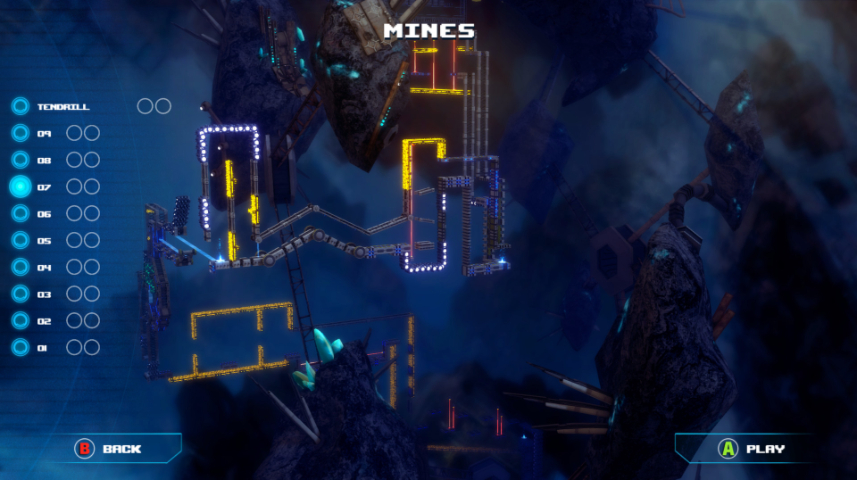Recycling is Earth’s best friend, but that all ceases to exist at a certain point. In Tinertia that point is when the player becomes the robot and he’s the target of the three Rs.
Tinertia, the product of a collaboration between Candescent Games and Section Studios, is an original twist to a very traditional formula – platform games. The player takes control of a small, cannon-propelled robot in the strange, mechanical world of Tinertia. Fleeing Tinertia and its mysterious artificially-intelligent A.R.C, players are equipped with no weapons, relying instead on their thrust cannon to escape the metallic horrors of recycling.
The game’s mechanisms are relatively simple, yet astonishingly effective and refreshing. Players use their mouse or, better yet, their controller to aim and shoot. Unlike the rest of platform games, players have to aim at the ground and shoot to jump, rather than simply pressing a button. And if you need a boost, just aim backwards and shoot. Whilst the physics aspect could come off as demanding, this is not the case in Tinertia.
The game starts off rather easily, allowing the player to find his bearings, and the one thing gamers will learn first is that the game isn’t overly-punishing. Jumping via shooting a cannon quickly starts to feel natural, and players rarely need pixel-precision in order to reach their goals. No, the punishing part comes later in the game.
Taking over Weldon, the robotic protagonist, gamers will likely end up comparing Tinertia to games such as Super Meat Boy, in spite of their contrasting playing styles. Death is a common occurrence in every level, pushing players’ limits and forcing them to boost their reflexes or learn new techniques. The game does ease the player into the game with a number of well-placed visual tutorials, yet the player will find himself discovering otherwise-simple techniques in order to conquer levels and, later on, boss fights.
The boss battles will likely take players by surprise as the game’s relatively mild difficulty curve suddenly slopes up in exponential manner. A reminder of other rage-quit games, the boss battles will likely leave players infuriated, yet they also push them to discover new ways to play the game – some of which would likely be found only through chance. Just like the rest of the levels, death means that players have to re-attempt to conquer the boss battles from the level’s only respawn point – right in the beginning. In the meantime, if boss battles aren’t enough of a challenge, there are other ways players can challenge themselves in Tinertia.
Each level gives players two optional performance bars to beat, involving time constraints and a limit on the number of rockets fired. And if that’s not enough, Tinertia allows players to revisit the ravishing world in two different game modes – the Speedrun and #YOLO challenges.
Unfortunately, Tinertia’s promising storyline comes off as just a backstory to the game, at least in its Early-Access version. With no ingame introduction to what’s happening, Tinertia’s lore and Weldon’s endeavours remain a tale you read on the product’s case cover. The A.R.C signage scattered around the automated planet of Tinertia does invoke a 1984 feel, yet without the backing of a proper plot they’re simply smoke without fire. There are plans to introduce some sort of a storyline as the game develops, yet there are no plans to make the game story-centered. And while the game’s storyline is still underdeveloped, the graphics tell a story of their own.
The world of Tinertia doesn’t allow the mundane environment of mechanical gear restrict its he facade. The game’s obstacles manage to breathe life into the robotic planet, creating a factory-like habitat for Weldon not to simply fight through, but also to wonder at. The game’s graphics are refined, varied and polished, yet Tinertia’s visuals have their own issues.
The game’s graphics are coherent throughout the game, with dynamic backgrounds and animated foregrounds creating a sense of awe throughout the game, yet contrast becomes a problem on occasion. Weldon’s colors offer little in the way of visual distinction, and when there are a number of rocket projectiles flying around, as inevitably happens during action-packed boss fights, players find themselves frantically looking for their robot on the screen. On the other hand, Tinertia’s variation makes any playthrough as interesting as the one preceding it.
The game currently boasts three unique environments, yet there are plans to introduce five more. Each environment so far is refreshing, introducing new obstacles and mechanical enemies, whilst the boss battles are well-animated. Yet in spite of the game’s excellence in gameplay and graphics, the soundtrack feels out of place.
Tinertia’s sound effects are just about what we’ve come to expect from an action platform game – simple, yet helping the player immerse himself in the game. Unfortunately, the same can’t be said about the included score. With Tinertia encouraging fast-paced gameplay and action-packed playthroughs, the musical soundtrack is remarkably mellow at times, taking away from the game’s rapid pace.
Speedy gameplay and rocket-wasting is the order of the day in Tinertia. Incorporating challenging levels and innovative gameplay whilst remaining fair throughout, Tinertia will likely apply to a broad spectrum of the gaming community. With a world that not only looks, but also feels alive, a single aspect holds back Tinertia – a solid, non recycled storyline.














You must be logged in to post a comment.